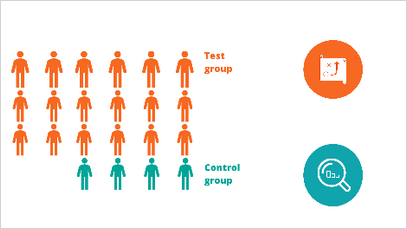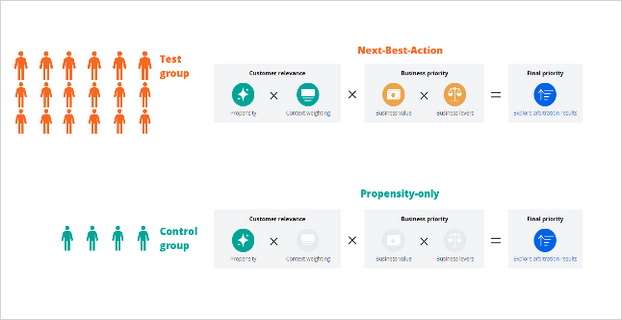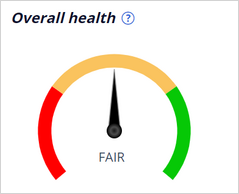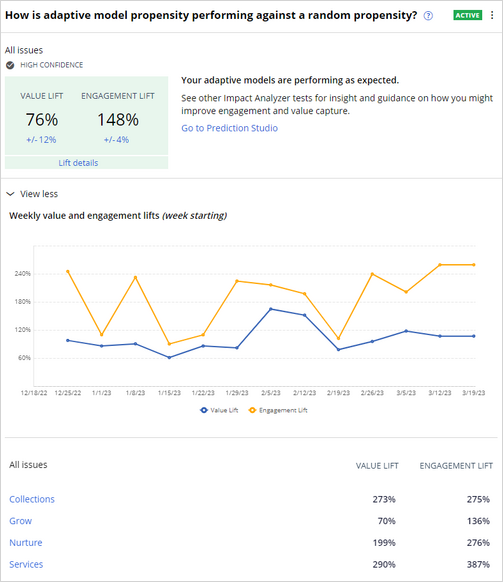
Monitoring the health of the system using Impact Analyzer
Impact Analyzer is a proactive monitoring tool that shows the overall health of your actions and highlights opportunities for improvement. The tool provides insight into the performance of your next best actions through the results of experiments that tell you what actions and configurations are working as expected, and where you can still improve.
Video
Transcript
Impact Analyzer is a feature of Pega Customer Decision Hub™ that uses experimentation to track the effectiveness and overall health of next best actions. By utilizing this tool, you can gain insights into the effects of arbitration. Impact Analyzer conducts experiments with alternative prioritization and engagement policy filters on a small control group of customers. This enables you to assess whether or not the next best action is producing a positive effect. In addition to monitoring for basic lift, these control group experiments can also reveal opportunities to optimize and align the next best actions with your business goals.
An experiment is a test with two sets of participants, the test group and the control group, in which the test group receives the originally arbitrated action and the control group receives an alternate action based on the type of experiment.
You can use Impact Analyzer to carry out a variety of tests. For example, you can assess the effectiveness of the next best action against a random relevant action or actions, chosen based on propensity alone. Additionally, you can measure the performance of the next best action when arbitrating with no levers. You can also evaluate the performance of the adaptive model propensity against a random propensity.
Impact analyzer continuously monitors the health of the next best actions in the experiment, and presents the results in the form of two key performance indicators (KPIs): value lift, and engagement lift. Value lift measures how much a business can make from suggesting certain next best actions to customers, compared to a random relevant action. Engagement lift measures how much more likely customers are to click or accept a suggested next best action, compared to the random relevant action.
When a next best action is delivering lift, the overall health indicator highlights in green. The middle position of the indicator shows that there is room for improvement to better align actions to the business. The red highlight [the section on the left] means that something is wrong and needs your attention. The indicator is colored gray when the general health is not available due to insufficient data in one or more active tests.
Impact Analyzer is available under Discovery tab in the left menu of Customer Decision Hub.
One of the experiments that you can run is called How is Next-Best-Action performing against a random relevant action?
This test serves as a baseline check to ensure that the next best action is beating the random relevant action. At the very least, we expect the value lift - and ideally, both the value and engagement lift - to be positive, at the highest level across all issues and groups aggregated. If both value and engagement lifts are negative, there is an issue. This could mean that there is a problem with the underlying adaptive models, or that your engagement policies are too targeted. Another reason might be that your levers are excessively biased, and the next best action lacks the aptitude to optimize engagement or to capture value.
The test widget presents a value lift of 128 percent and an engagement lift of 171 percent. Both values are positive, and the test is highlighted in green.
Another experiment is called How is adaptive model propensity performing against a random propensity?
This experiment compares only Pega AI-driven model propensity with no context weight, no business value, and no business levers, against only randomly generated propensity. The experiment is another baseline check to ensure that the adaptive models that a next best action uses are delivering lift over random propensity.
To monitor for basic lift, both presented experiments should be on at all times.
Impact Analyzer offers a range of benefits to its users. One of the most significant benefits is the ability to collect data in real-time, allowing for real-time monitoring and testing of KPIs. Impact Analyzer also enables users to look for opportunities that they may have otherwise missed.
The primary user of Impact Analyzer is the Next Best Actions operations team, who are responsible for ensuring that the system runs optimally. However, the tool brings value to various lines of business, sales, marketing, and Data Scientists.
You have reached the end of this video. You have learned:
- How Impact Analyzer continuously monitors the performance and health of the system.
- How Impact Analyzer conducts experiments by implementing alternative prioritization and engagement policy filters on a small control group of customers, to assess the effectiveness of next best actions.
- How the experiments reveal opportunities to optimize and align next best actions with business goals.
This Topic is available in the following Modules:
If you are having problems with your training, please review the Pega Academy Support FAQs.
Want to help us improve this content?







